By Ben J. Novak
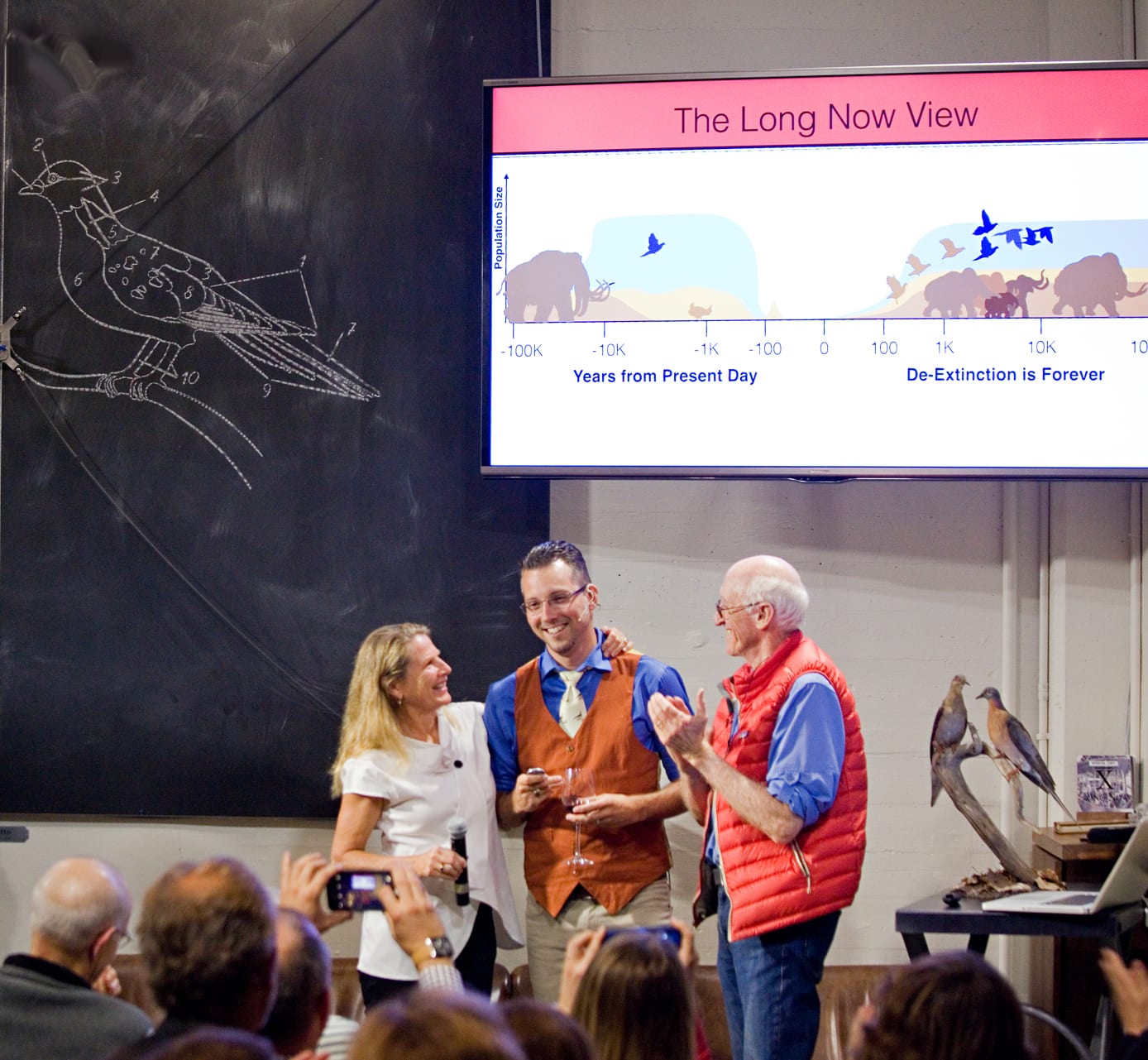
Ryan Phelan and Stewart Brand congratulate Ben Novak at the Interval after Novak’s talk on his master’s thesis research for “the Great Passenger Pigeon Comeback”, September 27, 2016.
When Revive & Restore started working on Passenger Pigeon de-extinction four years ago, we hypothesized that the passenger pigeon could be a model species to develop the science of de-extinction. The Passenger Pigeon is certainly an iconic candidate. Conservation has often rallied behind iconic birds to galvanize environmental revolutions – modern conservation itself began with the extinction of the Passenger Pigeon. When the bird went extinct in 1914, it was a somber awakening of the power of industrial humanity to wipe out even the most abundant of natural resources.
Since then, new insights have revealed the Passenger Pigeon isn’t simply a model species; it quite possibly is the most important species for the future of conserving eastern America’s woodland biodiversity. Research on the Passenger Pigeon’s ecology and habitat revealed its vital role: the Passenger Pigeon was the ecosystem engineer of eastern North American forests for tens of thousands of years, shaping the patchwork habitat dynamics that eastern ecosystems rely on, ecosystems now losing diversity without the Passenger Pigeon’s engineering role.
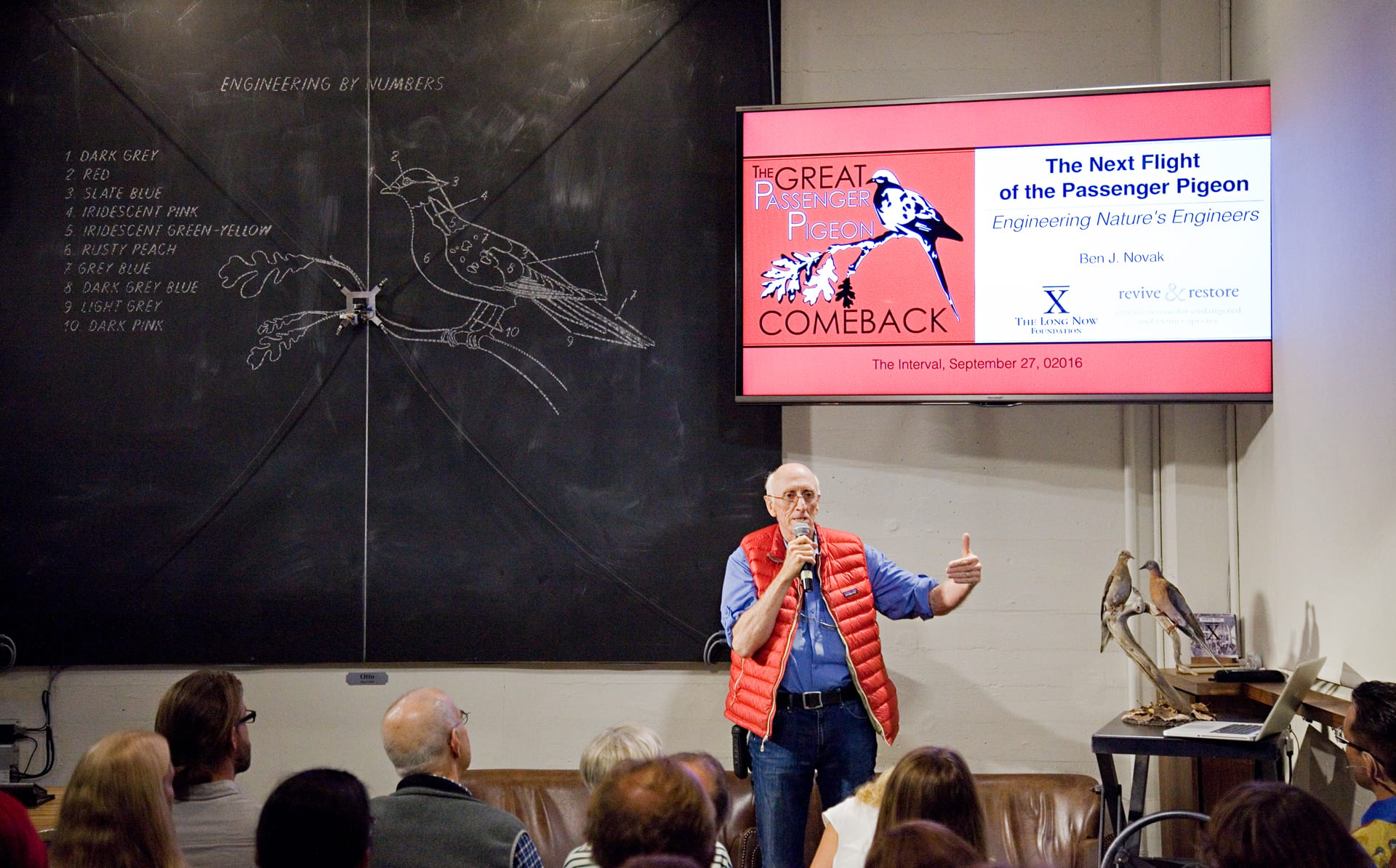
Stewart Brand introduces the inception of Ben Novak’s thesis research at the Long Now Foundation’s Interval Salon & Bar, September 27, 2016.
The Beginning
“The Great Passenger Pigeon Comeback” began in 2012 with a central paradigm: de-extinction needed a model candidate. The goal of de-extinction for us, quite literally is revive and restore, and so the pilot project needed to be one that would have a likelihood of success returning a species to the wild. But how do we restore a species to the wild that is gone? Reintroducing species into areas where they were extirpated is decades-old science (examples include wolves in Yellowstone, Elk in Kentucky, Beaver in Scotland). Reintroduction requires a thorough knowledge of the ecology of the species to be reintroduced as well as the state of the habitat in which reintroduction will occur.
De-extinction requires more than simply reintroducing a species. First, the extinct species has to be revived, and that science is new. To revive a species scientists need its DNA, a living surrogate, and knowledge of the reproduction of both the extinct species and the surrogate. Therefore, the model species – the one to troubleshoot de-extinction – needed to be a strong candidate for the sciences of both revival and reintroduction. The Passenger Pigeon proved to be a strong candidate in both spheres.
Why does the Passenger Pigeon meet they necessary criteria for de-extinction?
First, the necessary scientific knowledge and genetic material to revive Passenger Pigeons exists. There is usable DNA because there are more stuffed Passenger Pigeons resting in museum drawers and private collections than any other extinct bird. There is also a living surrogate. The Band-tailed Pigeon has been identified as the closest living relative of the Passenger Pigeon based on DNA sequencing. Lastly, their reproduction is well understood; pigeons have been bred in captivity for centuries with great success. The science of revival seemed as though it should fall into place with the right innovation and perseverance.
Second, returning the Passenger Pigeon to the forests of the eastern United States would fulfill a key ecological function.
But what do we know about the pigeons’ ecology? The ecology of the Passenger Pigeon has been a debated topic for over a hundred years. Since the study of ecology did not become a science until the 1930’s, the ecology of any species that disappeared before then was never studied scientifically, and the majority of what we think we know about the Passenger Pigeon rests on foundations of hypothetical assumptions.
My own hypothesis was that Passenger Pigeon de-extinction would have two likely outcomes:
(1) Neutral — meaning it would just be another bird in the forest.
(2) Beneficial — meaning it would have a positive impact on other species.
Reintroduction of a species always poses potential risks, which must be assessed as much as the anticipated benefits. It is also important to assess the outcomes of choosing not to reintroduce the species. Taking no action could have a neutral impact (with nothing changing, which would be okay) or negative consequences (in which case, the ecosystem degrades). Properly weighing these outcomes requires a clear scientific understanding of the Passenger Pigeon’s ecology.
A Clarified Natural History
With the help of dozens of collaborators, I’ve been reconstructing a clearer natural history of the Passenger Pigeon, so that we can restore the species successfully and responsibly.
Below is a summary of the findings of my thesis: Deciphering the Ecology of the Passenger Pigeon: a synthesis of paleocecology, physiology, and morphology.
We used DNA sequences from 42 Passenger Pigeons spanning 4,000 years of history to reconstruct historic population trends. What we found contradicted every previous hypothesis: Passenger Pigeons had been stably abundant for tens of thousands of years (possibly even longer). While many species experienced population upswings and downswings in conjunction with ice ages and changes in habitat, the Passenger Pigeon was a constant. It was abundant during times when deciduous trees were rare and when ice sheets covered half of its known range. The commonly cited assumption that its habitat and diet were dependent on oak, beech, or chestnut trees cannot be true in light of this discovery. The take home message: the Passenger Pigeon was an ecologically resilient species, a generalist capable of thriving under changing conditions.
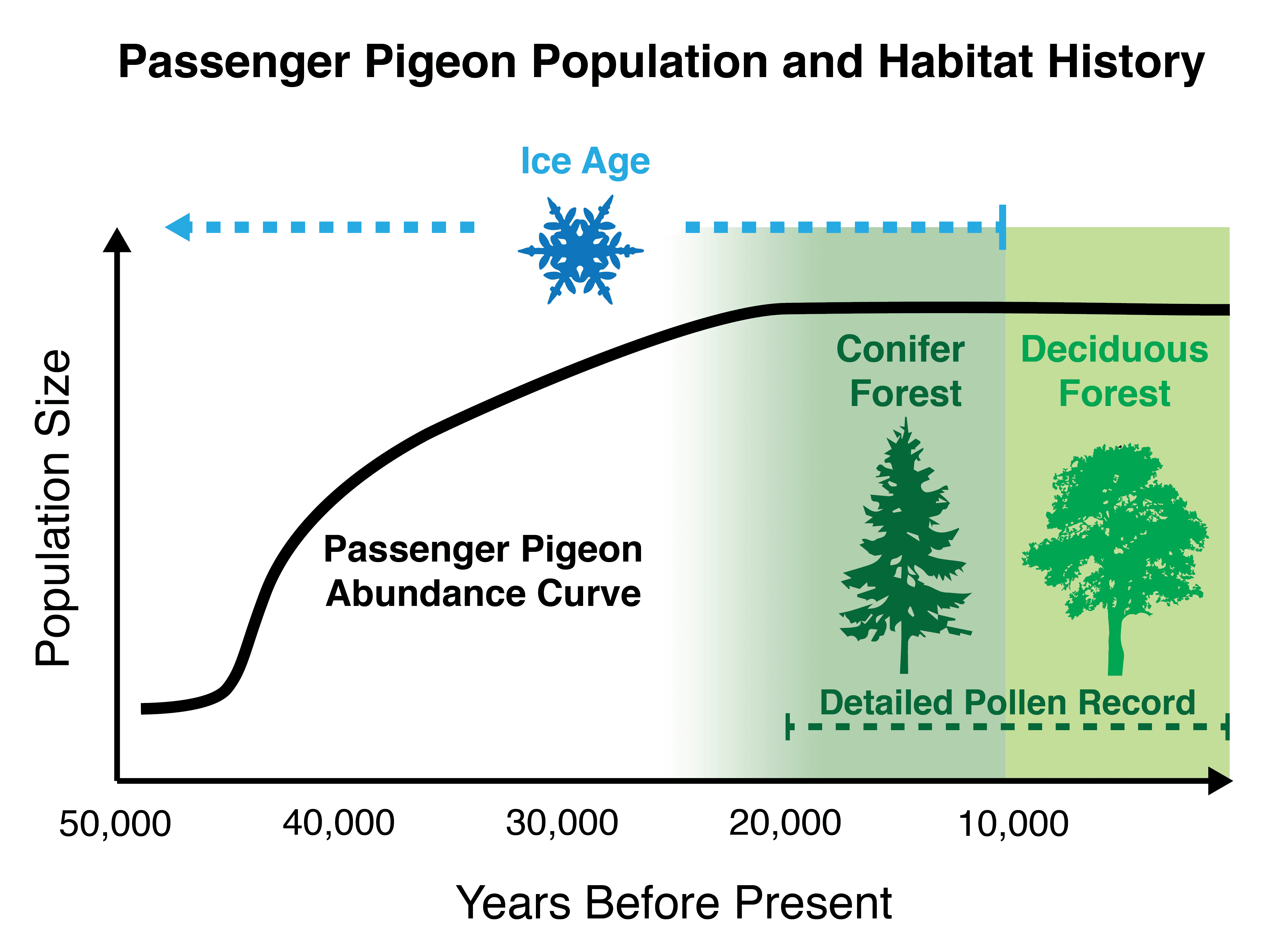
This also means that the large flocks observed in the 1800’s were not an uncharacteristic short-lived phenomenon, but a long-term force of nature. The great forest disturbances created by Passenger Pigeon megaflocks – which were described by American ornithologist John James Audubon as similar to tornadoes – were a constant variable in the formula of eastern forest habitats. Passenger Pigeons were generating disturbances – driving patchwork environments – for thousands of tree and animal generations. And when we look at the species inhabiting eastern forests, we find countless disturbance-dependent species; in fact, the entire community was a disturbance regime. Today, most eastern species are in decline because regenerating habitats no longer exist other than those made by humans. In short, the Passenger Pigeon shaped the forest, and today’s forests will continue suffering extinctions if the disturbance and regeneration regimes are not restored.
Populations consisting of billions of birds that existed for tens of thousands of years would have had significant impacts on food resources, so understanding these impacts is vital to managing reintroduction efforts.
We now know Passenger Pigeons were primarily seed predators thanks to analyses made of Band-tailed Pigeon diets. And it is because of their diet that the Passenger Pigeon had an intricate effect on food chains and the evolution of other species. Both my master’s research and a new field study show the species played a part in dispersing seeds post-mortem.
But what were the pigeons consuming and dispersing? By studying the morphology of pigeon jaw sizes, I was able to assess the extent of Passenger Pigeon foraging. In short, the species had no trouble consuming small seeds. However, the largest seeds in the forest, like the largest Northern Red Oak acorns, were too big to swallow. This means that Passenger Pigeons impacted small seed bearing plants much differently than they did large seed bearing plants. This also means the birds presented different competition intensity in different habitat types and varying levels of competition to other seed eating species. In summation, the ecology of the Passenger Pigeon is much more complex than anyone has ever considered.
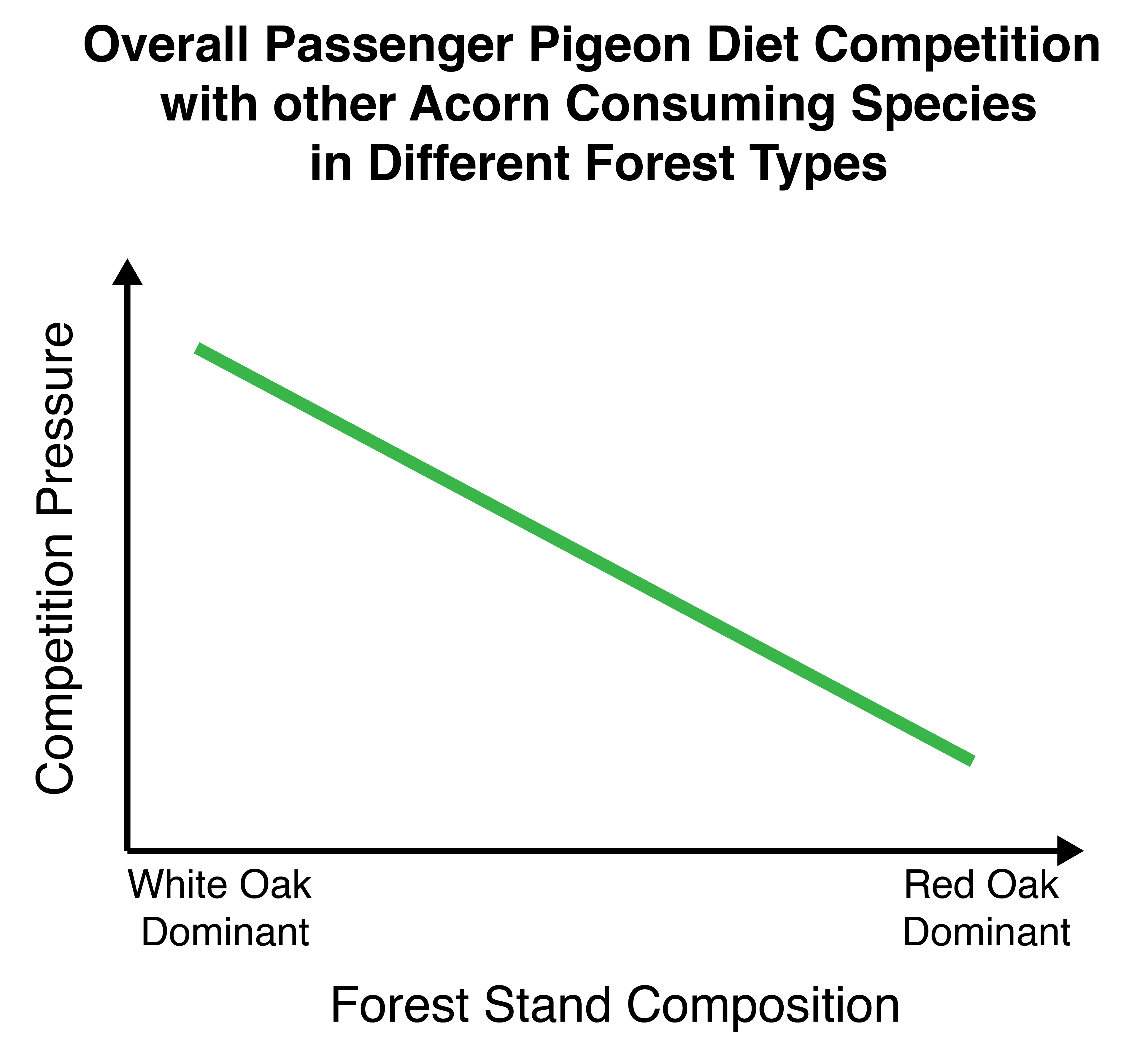
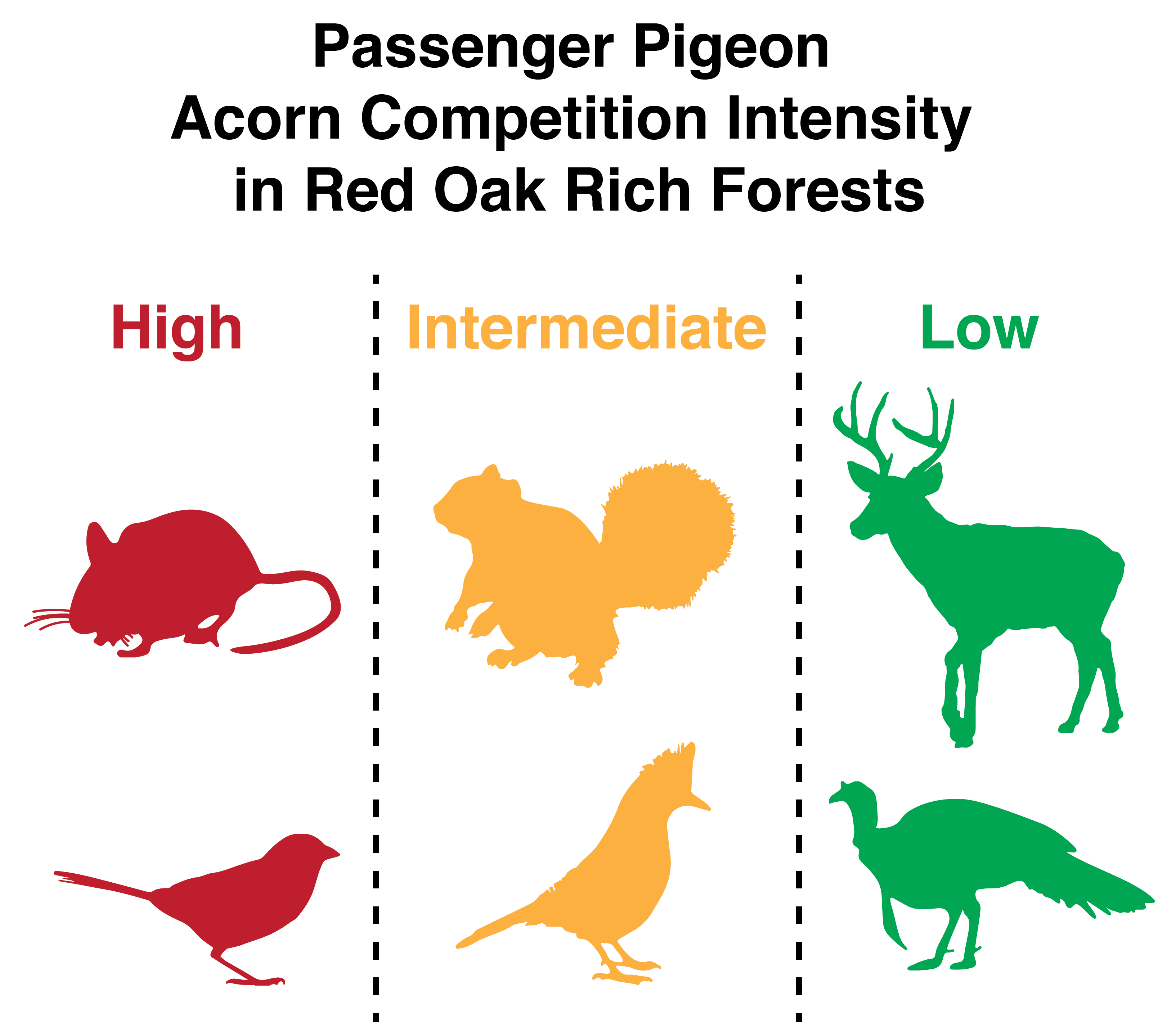
The Big Picture
By drawing from every source of information we have to model the ecology of the Passenger Pigeon – including comparisons to analogous species, analyses of historic accounts, and new discoveries – we can piece together a vision of the species dynamic ecological cycle.
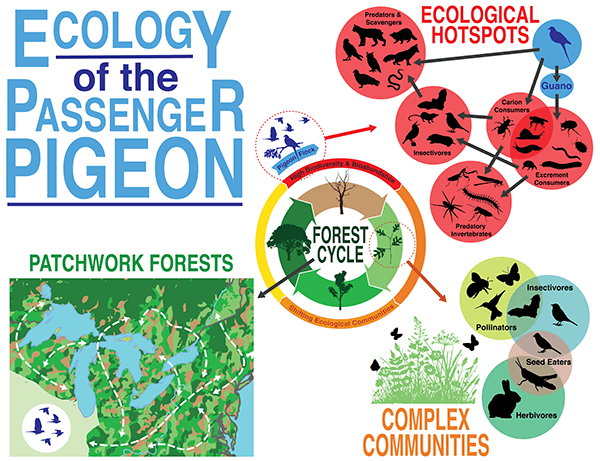
- Patchwork Forests – The density and size of Passenger Pigeon flocks generated two major effects when the birds nested and roosted: canopy thinning (the breaking of branches from overcrowding) and understory disturbance (huge deposits of guano snuffed out vegetation). Passenger Pigeons were like a storm and a wild fire all in one. The result was forest regeneration, creating successional habitat types or “patches.” Historically, the nomadic movements of Passenger Pigeons set the forest cycle in motion throughout eastern forests, creating a mosaic of heterogeneous habitat types, fostering a higher level of biodiversity and bioproductivity than any single homogenous habitat is capable.
- Ecological Hotspots – Historic records show that pigeon nestings were a boon to predators, and new observations of similar colonial nestings of Starlings in Australia show that dense concentrations of nesting birds generate ecological hotspots of biodiversity and bioabundance. The huge deposits of guano create a rich community of decomposers, which in turn, produce a food chain cascade lasting months after the birds leave the area.
- Complex Communities – Canopy thinning allows sunlight to reach the forest floor, enabling thick understory vegetation to grow. Forest patches foster a variety of flowering plants that attract pollinators and herbivores, setting the scene for a rich food chain of species. Reptiles and amphibians take advantage of the warm sunlight and abundant insect and bird densities. The thick vegetation offers cover for small mammals to raise offspring. The visibility at the edge of these patches is ideal areas for predatory birds to scan for prey and for nesting songbirds to spot predators. As the forest regenerates and the canopy closes again, the communities shift, creating ideal roosting sites for bats, owls, squirrels, woodpeckers, and many more canopy-dwelling animals, many of which roost in secure closed canopy and hunt in nearby open patches in the mosaic forest. Patches of mature oaks and chestnuts provide ample seed crops for diverse foragers and attracted the pigeons to come back and restart the cycle once again.
This is the incredible ecology that Passenger Pigeon de-extinction offers to revitalize in eastern North America’s forests.



